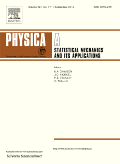
PHYSICA A-STATISTICAL MECHANICS AND ITS APPLICATIONS
Scope & Guideline
Advancing Knowledge in Condensed Matter Physics.
Introduction
Aims and Scopes
- Statistical Mechanics and Thermodynamics:
The journal publishes research on fundamental aspects of statistical mechanics and thermodynamics, exploring the properties of systems at macroscopic scales and their underlying microscopic interactions. - Complex Systems and Network Theory:
A significant focus is placed on the analysis and modeling of complex systems, including social networks, transportation systems, and biological networks, emphasizing how interactions within these systems lead to emergent phenomena. - Applications in Socioeconomic Dynamics:
Research that applies statistical mechanics and complex systems theory to socioeconomic issues, including market dynamics, financial systems, and public health, is a key area of interest. - Traffic Flow and Evacuation Modeling:
The journal features studies on traffic flow dynamics, evacuation behavior, and the integration of connected and autonomous vehicles in mixed traffic environments, employing models that account for human behavior and decision-making. - Quantum Mechanics and Information Theory:
There is a growing emphasis on quantum mechanics, particularly in relation to entanglement, quantum information theory, and its implications for statistical mechanics.
Trending and Emerging
- Machine Learning and Data Science Applications:
There is a significant rise in the application of machine learning and data science techniques to model complex systems, predict behaviors, and analyze large datasets, particularly in socioeconomic and traffic systems. - Quantum Information and Entanglement Studies:
Research focusing on quantum information, entanglement dynamics, and their applications in statistical mechanics has become increasingly prominent, reflecting the growing interest in quantum technologies. - Behavioral Dynamics in Social Systems:
Emerging themes include the modeling of human behavior and decision-making in social networks, particularly in the context of crises like the COVID-19 pandemic, showcasing a blend of psychology, sociology, and physics. - Resilience and Vulnerability Analysis:
There is an increasing emphasis on the resilience and vulnerability of complex networks, particularly in transportation and social systems, as researchers seek to understand how these systems can withstand shocks. - Interdisciplinary Approaches to Societal Problems:
The journal is trending towards interdisciplinary research that combines insights from physics, economics, sociology, and environmental science to address complex societal challenges.
Declining or Waning
- Classical Thermodynamics:
Research specifically focused on classical thermodynamics, as opposed to statistical mechanics, seems to be receiving less attention, possibly due to the increasing interest in statistical approaches and computational methods. - Basic Quantum Mechanics:
Studies that cover foundational aspects of quantum mechanics without applications to statistical mechanics or complex systems are less frequently published, suggesting a shift towards more applied research. - Static Network Analysis:
Analysis of static networks without considering dynamic interactions or temporal aspects has declined, as researchers increasingly focus on dynamic and adaptive network models. - Single-Discipline Focus:
There is a noticeable decrease in papers that focus solely on one discipline, such as pure physics or chemistry, with an increased emphasis on interdisciplinary research that combines physics with social sciences, economics, and data science.
Similar Journals
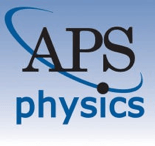
REVIEWS OF MODERN PHYSICS
Connecting Ideas and Discoveries in PhysicsREVIEWS OF MODERN PHYSICS, published by the American Physical Society, stands as a premier journal in the field of physics and astronomy, evidenced by its esteemed Q1 ranking in the 2023 category. With a notable ISSN of 0034-6861 and E-ISSN of 1539-0756, this journal has been a cornerstone for scholarly excellence since its inception in 1929. Operating from the heart of the United States at One Physics Eklipse, College Park, MD 20740-3844, REVIEWS OF MODERN PHYSICS enjoys a significant reputation, holding a top rank of #1 out of 243 in the Scopus rankings for General Physics and Astronomy, and securing its place in the 99th percentile. While it does not provide open access, the journal remains a critical resource for researchers and students alike, offering comprehensive reviews and breakthroughs that drive innovation and understanding in modern physics. As it converges towards its centennial year in 2024, the journal continues to foster significant academic discourse, making it an invaluable platform for the dissemination of pioneering ideas and research outcomes.
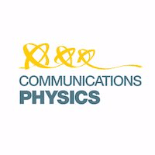
Communications Physics
Exploring the universe of scientific communication.Communications Physics is a premier open access journal published by Nature Portfolio, dedicated to disseminating high-quality research in the field of Physics and Astronomy. Since its inception in 2018, the journal has rapidly established itself as a vital platform for innovative scientific communication, boasting an impressive Impact Factor and achieving Q1 status in the 2023 category of Physics and Astronomy (miscellaneous). With a Scopus rank of #31 out of 243, placing it within the 87th percentile, Communications Physics attracts a global audience of researchers, professionals, and students eager to engage with cutting-edge findings. The journal supports open access, ensuring that research is freely available to the public, which enhances its visibility and encourages broader discussions within the scientific community. Located in Berlin, Germany, Communications Physics aims to bridge the gap between various disciplines within physics, fostering interdisciplinary collaboration and inspiring future research endeavors.
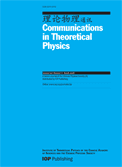
COMMUNICATIONS IN THEORETICAL PHYSICS
Elevating theoretical discourse to new heights.COMMUNICATIONS IN THEORETICAL PHYSICS is a distinguished journal published by IOP Publishing Ltd, focusing on the broad and evolving field of theoretical physics. With an ISSN of 0253-6102 and an E-ISSN of 1572-9494, this journal provides a platform for the dissemination of innovative research that contributes to the understanding of complex physical concepts. Situated in the United Kingdom, it has established itself as a pivotal resource from 1996 to 2024, achieving a commendable Q2 ranking in the category of Physics and Astronomy (miscellaneous) for 2023. With a Scopus ranking of #18 out of 81 in its category, demonstrating a 78th percentile, this journal plays a crucial role in enhancing scholarly communication among researchers, professionals, and students alike. Although it does not currently offer Open Access options, the journal's comprehensive scope and commitment to high-quality peer-reviewed research underline its significance in the scientific community, making it an essential reading for anyone engaged in theoretical physics.
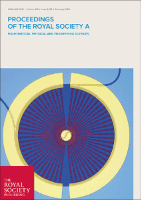
PROCEEDINGS OF THE ROYAL SOCIETY A-MATHEMATICAL PHYSICAL AND ENGINEERING SCIENCES
Fostering Interdisciplinary Excellence in Mathematical and Physical Sciences.PROCEEDINGS OF THE ROYAL SOCIETY A-MATHEMATICAL PHYSICAL AND ENGINEERING SCIENCES is a prestigious academic journal published by the Royal Society in the United Kingdom, dedicated to the dissemination of high-quality research in the fields of Mathematics, Engineering, and Physics. With an esteemed impact factor and ranked in the top quartiles (Q1) across various categories, this journal stands out as a leading source of innovative findings and critical discussions within the global scientific community. Researchers benefit from its comprehensive coverage that spans from theoretical explorations to practical applications, and the journal plays a crucial role in advancing knowledge and fostering interdisciplinary collaboration. Although it does not currently offer Open Access options, its influence is underscored by notable Scopus rankings, evidencing its significant contribution to the fields it represents. Located at 6-9 Carlton House Terrace, London SW1Y 5AG, England, the journal continues to be a cornerstone for scholars seeking to publish impactful research and stay informed on the latest advancements in science and engineering.
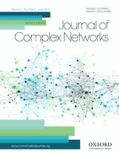
Journal of Complex Networks
Connecting Ideas in Applied Mathematics and NetworksJournal of Complex Networks, published by Oxford University Press, stands as a prominent platform in the fields of Applied Mathematics, Computational Mathematics, and Computer Networks and Communications. Since its inception in 2013, this esteemed journal has garnered a strong reputation, achieving a Q2 category ranking across multiple disciplines in 2023, indicating its influence and quality in the relevant academic circles. With an ISSN of 2051-1310 and E-ISSN 2051-1329, it aims to facilitate the understanding of intricate network systems and their applications, positioning itself at the forefront of cutting-edge research. While the journal currently does not offer Open Access options, it remains a vital resource for researchers, professionals, and students seeking insights into the dynamic interplay between networks and computational methodologies. Its commitment to promoting rigorous research is reflected in its impressive Scopus rankings, which highlight its intersectional impact on various mathematical and computational disciplines. Contributing to this journal provides authors with an opportunity to engage with a broad audience dedicated to advancing knowledge in complex networks, optimization, and management science.

Nonlinear Phenomena in Complex Systems
Transforming Insights into Nonlinear ChallengesNonlinear Phenomena in Complex Systems, published by BELARUSSIAN STATE UNIV, JOINT INST POWER & NUCLEAR RESEARCH, is an emerging platform dedicated to advancing the understanding of nonlinear phenomena within complex systems. With an ISSN of 1561-4085 and an E-ISSN of 1817-2458, this journal serves as a vital resource for researchers spanning the fields of mathematical physics and statistical and nonlinear physics. While classified within the Q4 quartile for both disciplines as of 2023, we encourage authors to submit impactful research that addresses the intricacies and challenges presented by complex systems, which are pivotal in various scientific applications. Targeting an international audience, including researchers, professionals, and students, the journal aspires to foster collaboration and innovation by offering open access to its insightful articles. With a converged publication timeline from 2009 to 2024, Nonlinear Phenomena in Complex Systems is poised to become a significant contributor to the evolving dialogue around nonlinear dynamics and their implications across multiple scientific domains.
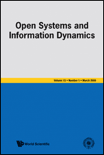
OPEN SYSTEMS & INFORMATION DYNAMICS
Fostering Innovation in Computational Sciences and Beyond.OPEN SYSTEMS & INFORMATION DYNAMICS, published by World Scientific Publishing Co Pte Ltd, is a leading international journal dedicated to advancing research in the interdisciplinary areas of computational mechanics, information systems, and mathematical physics. With its ISSN 1230-1612 and E-ISSN 1793-7191, the journal has established itself as an influential platform for disseminating original research findings, reviews, and methodologies that address complex systems and dynamics. Its current impact factor reflects a solid reputation within the academic community, particularly amongst researchers in the fields of physics, statistics, and computational sciences. The journal's scope encompasses a diverse array of subjects, earning a Q2 classification in Computational Mechanics and Q3 in multiple other categories, including Fluid Flow and Transfer Processes and Information Systems. By providing open access to a wealth of knowledge, OPEN SYSTEMS & INFORMATION DYNAMICS is committed to fostering collaboration and innovation for students, researchers, and industry professionals alike, positioning itself as a cornerstone of scientific exploration and discovery in Singapore and beyond.

Entropy
Bridging disciplines to tackle complex scientific challenges.Entropy is an esteemed open-access journal published by MDPI since 1999, dedicated to the dissemination of research in the fields of Electrical and Electronic Engineering, Information Systems, Mathematical Physics, and Physics and Astronomy. Based in Switzerland, Entropy has garnered significant recognition, achieving a Q2 category ranking across multiple disciplines in 2023, including a commendable 90th percentile rank in Mathematical Physics. The journal not only embodies a commitment to high-quality scholarly content but also serves as a platform for interdisciplinary dialogue among researchers and practitioners. With a robust e-ISSN of 1099-4300, it offers easily accessible publications that encourage collaborations and innovations in tackling complex scientific problems. Researchers, students, and professionals alike will find valuable insights through its curated articles, making Entropy an essential resource for advancing knowledge in its respective fields.
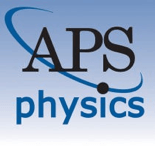
PHYSICAL REVIEW E
Fostering Collaboration in Physics and MathematicsPHYSICAL REVIEW E, published by the American Physical Society, stands as a premier journal in the fields of condensed matter physics, statistical and nonlinear physics, and statistics and probability. With an ISSN of 2470-0045 and an E-ISSN of 2470-0053, this journal prides itself on providing cutting-edge research and insights, contributing significantly to the advancement of knowledge since its inception in 1993. Currently, it boasts a Q1 ranking in Condensed Matter Physics and a Q2 ranking in both Statistical and Nonlinear Physics and Statistics and Probability, highlighting its relevance and impact within these fields. PHYSICAL REVIEW E is particularly renowned for its commitment to disseminating high-quality, peer-reviewed articles that address fundamental questions and emergent phenomena, making it an essential resource for researchers, professionals, and students alike. As it converges years from 1993 to 2024, the journal continues to foster a collaborative environment for innovative research while maintaining accessibility for a global audience.
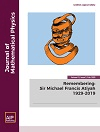
JOURNAL OF MATHEMATICAL PHYSICS
Pioneering research in statistical and nonlinear physics.Welcome to the JOURNAL OF MATHEMATICAL PHYSICS, a distinguished publication dedicated to the burgeoning fields of mathematical physics and statistical and nonlinear physics, published by AIP Publishing. Established in 1960, the journal continually showcases cutting-edge research and theoretical advancements that drive the understanding of complex systems and mathematical formulations within physics. With an impressive Scopus ranking of #38 in Mathematical Physics and #39 in Statistical and Nonlinear Physics, the journal is recognized for its vital contributions to the academic community, achieving a solid Q2 quartile ranking in both categories for 2023. While not an open-access journal, it remains a critical resource for researchers, professionals, and graduate students seeking insights into rigorous mathematical methods and their applications in physical sciences. Engage with the finest research as we converge toward new frontiers from 1960 to 2024, fostering academic collaboration and innovation.